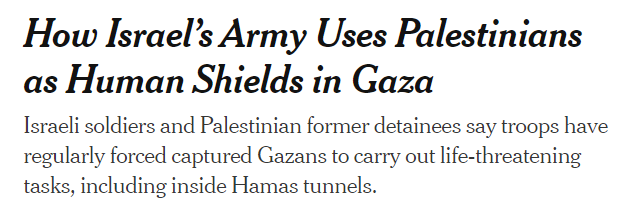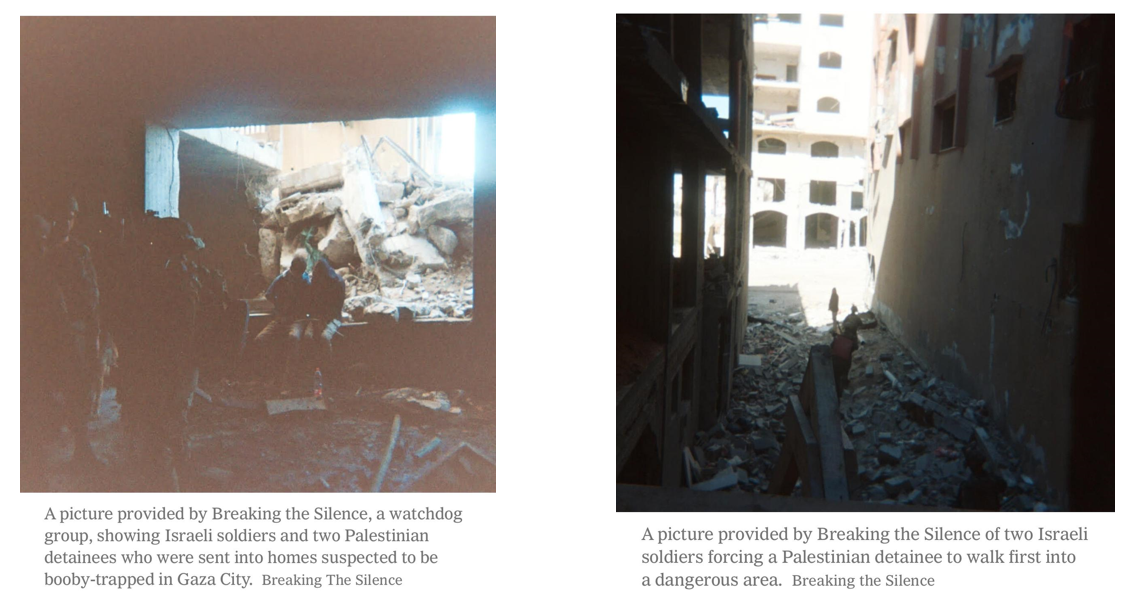Replete with a headline designed to tarnish Israel’s entire military, The New York Times this week published an investigation alleging that IDF soldiers were using Gazans as human shields during operations in the Gaza Strip.

In order to make its case, The New York Times says it “interviewed 16 Israeli soldiers and officials who knew about the practice, as well as three Palestinians, on the record, who were forced to take part in it.”
While the small number of Palestinians are named, the Israelis are not. It is always problematic to present anonymous testimony in a story where we don’t know the motivations behind those who are talking to the journalists.
The Role of Breaking the Silence
Two of the Israelis, however, were connected to The New York Times through Breaking the Silence, whose motivations are very clear. The organization, which was founded in 2004 by former IDF soldiers who are highly critical of Israel, claims to “expose the public to the reality of everyday life in the Occupied Territories” using testimonies that are purported to be “meticulously researched” while “all facts are cross-checked with additional eyewitnesses.”
However, as its critics have repeatedly alleged, the group appears to frequently rely on “either fabricated or exaggerated” testimonies from former soldiers — some of whom received a salary from Breaking the Silence — and are “motivated by financial and political concerns to further a pro-Palestinian agenda.”
Breaking the Silence also provided two photos to The New York Times for its story. Given the lack of context and the poor visual quality of both photos, it is impossible to confirm whether these images are evidence of anything let alone the captions that allege IDF misdemeanors.

It would be naive to suggest that every soldier in the IDF or any other comparable army behaves in an exemplary fashion. Only this last September, The New Yorker published a database of what it said is the “largest known collection of investigations of possible war crimes committed [by the U.S. military] in Iraq and Afghanistan since 9/11—nearly eight hundred incidents in all.”
Some of the alleged crimes include “the case of soldiers raping a fourteen-year-old girl and subsequently murdering her and her family; the alleged killing of a man by a Green Beret who cut off his victim’s ear and kept it; and cruelty toward detainees at Abu Ghraib prison and at the Bagram Air Base detention facility.”
All of this is not to claim that the IDF is necessarily more moral than the American military although there is certainly a good case to be made. The point is that nobody would condemn the entirety of the U.S. Army as an immoral entity that brings shame to its country despite the behavior of a minority of its troops.
Yet when it comes to New York Times coverage of and investigations into the IDF, it’s impossible to ignore the Gray Lady’s wider agenda that continuously seeks to delegitimize Israeli self-defense against the terrorists who are currently attacking it from multiple fronts.
For example, only days ago, the paper published a story that accused Israel of committing war crimes and “shooting children at point-blank range.” That story also relied on questionable testimonies and even more questionable X-rays purporting to show IDF bullets lodged in the heads of Palestinian children. The very authenticity of the X-rays was called into question as the entire story was torn apart online.
When it comes to verifying evidence and testimonies, The New York Times isn’t doesn’t exactly cover itself in glory.
Who Actually Uses Human Shields?
But hasn’t The New York Times also investigated Hamas’ use of human shields?
Yes and no.
On September 10, 2024, it published this story:

Yet despite the headline, the term “human shields” does not appear even once in the body of the article.
Nowhere is there an examination of how Hamas deliberately, as a policy, embeds itself within civilian infrastructure as a means of protecting its terrorists and their weaponry from Israel. Nowhere does it address how Hamas leaders are fully prepared to sacrifice innocent Gazans in pursuit of their own sick ideological goals. Indeed, the entire concept of human shields only works if you are facing an enemy that values human life and is not prepared to toss International Humanitarian Law and the Laws of Warfare into the wind.
Double Standards
But while one side, Israel, is committed to upholding those laws, the other side, Hamas plays by different rules. Of course, the IDF should be held to these standards and accountability is important to maintain them. That does not, however, give The New York Times a free pass to exercise double standards when it comes to the issue of human shields.
When @nytimes uses individual cases that go against the IDF’s own Code of Ethics to tarnish Israel’s entire army yet fails to address Hamas’ policy of using Gaza’s entire population as human shields, that’s not journalism, it’s a double standard. https://t.co/TnITu8Mmgv
— HonestReporting (@HonestReporting) October 14, 2024
Notably, it appears that while The New York Times is content to treat the IDF using human shields as fact, when it comes to Hamas, the terrorist organization’s use of human shields is treated as an Israeli claim despite evidence from Hamas operatives and leaders confirming this policy.
For example:
- “Al-Shifa, Israeli officials have argued, is an example of Hamas’s willingness to use hospitals as cover and turn civilians into human shields.”
- “The Israeli military says that Hamas has ‘cynically exploited’ schools, hospitals and shelters, using them as bases and civilians as human shields.”
What The New York Times Won’t Say
When asked by The Times of Israel about the New York Times story, the IDF responded that “the orders and instructions of the IDF forbid using civilians in Gaza who were arrested in the field for military missions,” adding that “The orders and instructions are made clear regularly to soldiers in the field during the war.”
This is key. What The New York Times won’t say is that all of the soldiers who spoke out have the option of reporting what they allege to have seen directly to a functioning investigatory system. As the IDF explains:
IDF forces are obligated to report incidents that raise suspicion for violations of the law or IDF orders. Any report (submitted by IDF forces or received otherwise), complaint, or allegation that suggests misconduct by IDF forces, undergoes an initial examination process, irrespective of its source.
In certain cases, the report, complaint, or claim received raises prima facie a reasonable suspicion for criminal misconduct (such as concrete allegations that raise a reasonable suspicion of looting or the abuse of detainees). In such cases, the MAG promptly orders to launch a criminal investigation. Criminal investigations of alleged misconduct occurring in the context of operational activity are conducted by a specialized department under the IDF Military Police Criminal Investigation Division, the National Unit for Operational Affairs. The unit’s work is directed by the MAG.
Put simply, there is an Israeli mechanism for investigating the very accusations that The New York Times has highlighted. In addition, Israel benefits from a multitude of civil society organizations and a free press that exists to hold those in power accountable.
The New York Times, however, is only interested in advocating for Palestinian welfare when it sees an opportunity to malign Israel. The IDF is certainly not beyond criticism or reproach. But is it too much to ask for The New York Times to ditch the double standards?
Probably, yes.
Liked this article? Follow HonestReporting on Twitter, Facebook, Instagram and TikTok to see even more posts and videos debunking news bias and smears, as well as other content explaining what’s really going on in Israel and the region. Get updates direct to your phone. Join our WhatsApp and Telegram channels!


